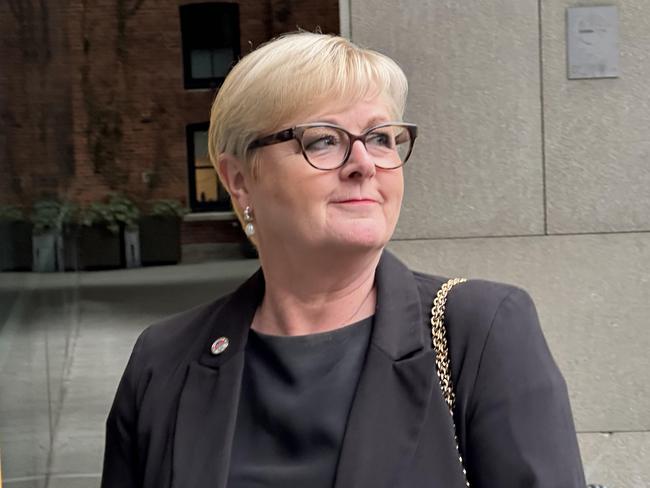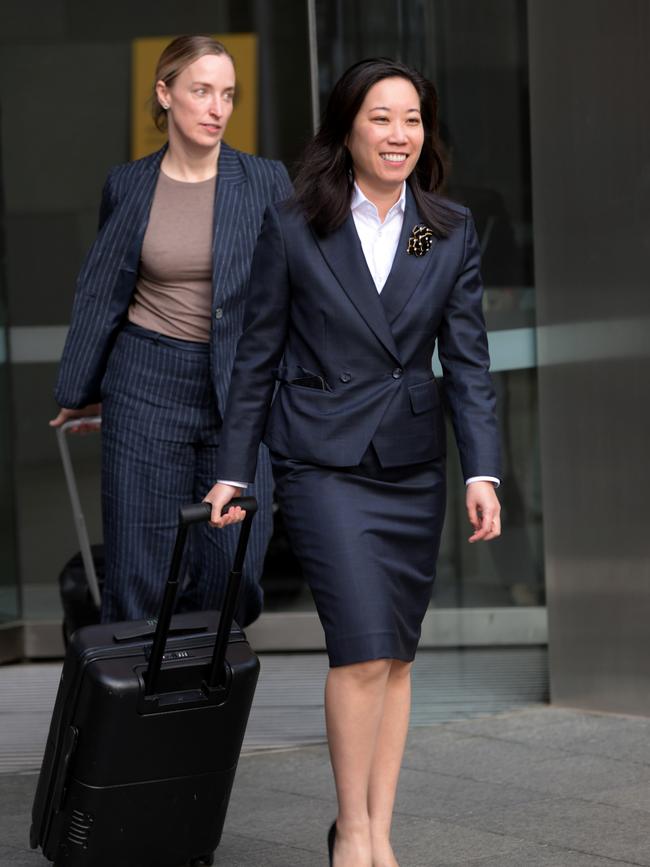Brittany Higgins silenced? I don’t think so
From the moment she decided to use the media instead of the police and the courts to tell her story, Brittany Higgins has been given extraordinary latitude to say whatever she wishes, whenever she wishes.

“Pertinent reading”, Higgins headlined the post.
Her timing was impeccable, albeit two weeks before it was her turn to take the stand.
Higgins sees herself as a disrupter, and her social media hijacking of the event achieved its purpose, dominating media coverage of the day Reynolds had hoped would provide some clear air to state her case.

Higgins elbowing her way to the forefront of the news coverage of the case delighted her loyal Instagram base, but in the real world her intervention highlighted the absurdity of her message. Higgins has not been silenced, by the law or by anyone else.
It is difficult to think of any complainant in any criminal or civil matter who has been more outspoken about their own case – or who has been more indulged by the legal system in flouting basic rules of fairness regularly enforced on others .
That perception was reinforced this week when judge Paul Tottle appeared to let Higgins’s provocative post through to the keeper, suggesting he would deal with it in submissions “when the time comes”.
Higgins’s lawyer, Rachael Young SC, said the post had nothing to do with the case, perhaps with her tongue planted firmly in her cheek, but promised to “speak to” her client.

The truth is, Higgins has been snubbing her nose at the legal system for years and getting away with it.
From the moment she decided to use the media instead of the police and the courts to tell her story, Higgins has been given extraordinary latitude to say whatever she wishes, whenever she wishes – all the while claiming she’s being gagged.
When Higgins delayed giving a formal statement to police, causing significant problems for the investigation, she and her partner David Sharaz were organising with journalists and Labor politicians to tell her story in the most explosive and politically damaging way possible for the Morrison government.
Television and online news interviews. The National Press Club. The Women’s March. The #MeToo movement. A $325,000 book deal. An unending stream of social media posts. Higgins wasn’t just given a voice – she was handed a megaphone.
When senior police officer Scott Moller asked that Higgins stop doing media that could prejudice Bruce Lehrmann’s criminal rape trial, Victims of Crime Commissioner Heidi Yates told him: “She can’t, Scott – she’s the face of the movement now.”
Silenced? Higgins has more platforms than Grand Central Terminal.
Let’s remember the first legal shot in this unending saga was fired by Higgins herself.
When the story broke, Reynolds, devastated at being accused of having walked past the rape of another woman, uttered her now infamous “lying cow” gibe. Higgins threatened to sue.
Under fire from all quarters over her alleged mishandling of rape allegations, Reynolds coughed up $10,000 to settle the matter even though she says she had been reacting to Higgins’s claims about her alleged mistreatment, not questioning the rape.
The two women signed a non-disparagement agreement. That has been repeatedly stretched by Higgins.
Over several months last year, Higgins published highly disparaging social media posts about Reynolds that have led to the current defamation case. Then in March, just as she and Sharaz were in mediation talks with Reynolds in a bid to settle the case, Higgins posted an image bearing the words “I won’t stay silent so you can stay comfortable”.
Two weeks before the trial began, Higgins announced she had been forced to sell her house in France as “the unspeakably high price” of speaking out on sexual assault. Cue more headlines.
But Higgins won’t be asked about the rape when she takes the stand. The only issue in this case is whether she defamed Reynolds.
No one will be stopping Higgins from telling the truth. Indeed, she’s running a truth defence.
No one has tried to silence her during any of the legal dramas that have run almost continuously through this tortuous affair.
Certainly not in Lehrmann’s criminal trial. When the trial was aborted through juror misconduct, ACT Chief Justice Lucy McCallum issued a plea for all parties to “fall silent” to ensure a fair second trial for the accused and to give Higgins “some respite from the media glare”.

Instead, Higgins walked straight into the media glare and denounced the legal system, deriding Lehrmann’s exercise of his right to silence and claiming that while her life had been publicly scrutinised, his had not.
Higgins declared the criminal justice system had “long failed to deliver outcomes to victims of sexual assault”; falsely asserted that Lehrmann had not been forced, like her, to surrender his mobile phone; and argued he had not been held accountable for “his actions”.
The speech appalled many legal observers. At that point Lehrmann was only months away from going back on trial. Other complainants have faced contempt charges for far less prejudicial comments.
But the ACT court ignored the two-fingered rebuff to its instructions and Higgins was free to continue working her curious brand of “silenced”.
When Lehrmann sued Network Ten and Lisa Wilkinson for defamation, Higgins agreed to give evidence. But only – according to a secret ultimatum through her lawyer – if Wilkinson wasn’t represented by barrister Sue Chrysanthou SC and instead employed the same lawyers as Ten. Silencing another woman is apparently OK if she’s a lawyer you don’t like. Even if she’s trying to nail your alleged rapist.
Justice Michael Lee ultimately found that on the balance of probabilities Higgins had been raped by Lehrmann, a verdict Higgins was happy to accept.
Less so the second part of Lee’s judgment: that her accusations of a political cover-up by Reynolds and her chief of staff, Fiona Brown, were completely false.

The claims were an invention by Higgins, Lee said, calling it “the only alleged cover-up of which I am aware where those said to be responsible for the covering up were almost insisting the complainant go to the police”.
Higgins hadn’t been silenced. She’d just been found out.
Higgins wasn’t silenced, either, when she sought compensation from the Albanese government for the mistreatment she claimed to have suffered.
Labor Attorney-General Mark Dreyfus refused to allow Reynolds to speak in her own defence in the one-day “mediation” that awarded Higgins $2.4m.
Dreyfus barred Reynolds from providing evidence in the case, threatening to tear up an agreement to pay her legal fees and any costs awarded if she tried to attend the mediation.
No one stopped Higgins speaking. No one even questioned the claims she made about her treatment by Reynolds and Brown, many of which we now know to be untrue. Reynolds told the court this week she was “incredibly angry because I could see that the Attorney-General of this nation was stitching me up”.
“I had no issue with Ms Higgins in this process at all. I was very clear that this was about the Attorney-General and how he had, I believe, corruptly manipulated the law to muzzle me.”
The only women who have genuinely been silenced in this tawdry affair are Reynolds and Brown.
Two middle-aged, conservative women who became disposable fodder in the febrile atmosphere of the #MeToo movement.
Reynolds had watched Wilkinson’s interview with Higgins on The Project with mounting horror – an account that bore so little resemblance to what Reynolds had actually said or done that “it was like a bomb went off in my head”.
In the days that followed Reynolds was torn apart in the Senate by Labor’s attack dogs, Penny Wong, Katy Gallagher and Kristina Keneally, then publicly rebuked by her own prime minister, Scott Morrison, for not informing him of the allegations.
Reynolds told The Australian last year that Morrison “expressed regret” to her, in private, the following day.
Brown suffered an even swifter fate, ostracised by her own colleagues and shamefully hung out to dry by the Morrison government and the Liberal Party she had faithfully served for years.
In her interview with The Project, Higgins gave Brown a starring role as chief villain – second only to the alleged rapist. But Lehrmann wasn’t named in the program. Brown was.
“It was like standing in front of a firing squad,” the former public servant told The Australian earlier this year. “It was the day that my life ended, as I knew it.”
Brown had personally walked Higgins down to the police office in Parliament House to report the incident at the first indication from the young staffer that some kind of sexual activity had occurred.
The respected public servant could not reconcile Higgins’s horrifying claims with the young woman who, on their last interaction, had sent her a note saying: “I cannot overstate how much I’ve valued your support and advice throughout this period. You’ve been absolutely incredible and I’m so appreciative.”
Brown took the fall for the Morrison government as it sought to deflect Labor’s accusations of a cover-up, unable to challenge a woman who said she had been raped.
No one in the prime minister’s office publicly supported Brown’s version of events. The roiling #MeToo movement had panicked the government, terrified of being labelled as rape-apologists, infecting the parliament, the courts and the media.
Brown was told not to respond to the allegations, warned by people within the prime minister’s office that a legal claim would just make the story bigger.
“It’ll run out of steam in two weeks,” they told her. It didn’t.
Higgins’s claims of cover-up were so incendiary that not even Coalition members could publicly challenge them.
“No one wanted to go against the movement,” Brown says.
The Project’s brutal portrayal of Brown ended her career and left her so traumatised that at one point not long after, she walked into the sea in a bid to end it all, saved by a caring young surfer who took her by the hand and pulled her back to shore.
Reynolds, at least, is able to have her day in court; Brown will never get the chance. She’s out of money and out of time – long past the statute of limitations to sue – and, in any case, is in no fit mental state to do so.
Brown begged to be excused from giving evidence in the Lehrmann defamation case. Lee turned off the live stream of the case to help her through the ordeal. As it turned out, she was the most impressive witness in the entire case, a woman with nothing to gain from the outcome and whose presence had come at enormous emotional cost. Lee was unerring in his praise of Brown’s conduct and integrity.
Now Brown is so ill she may not be able to give evidence on behalf of her old boss, Reynolds.
That’s what “silenced” looks like.






Just as Linda Reynolds stepped into the witness box to begin her evidence on Monday, Brittany Higgins launched her own dramatic early entry into the case, posting on Instagram the cover of a new book with the subtitle How the Law Silences Women.